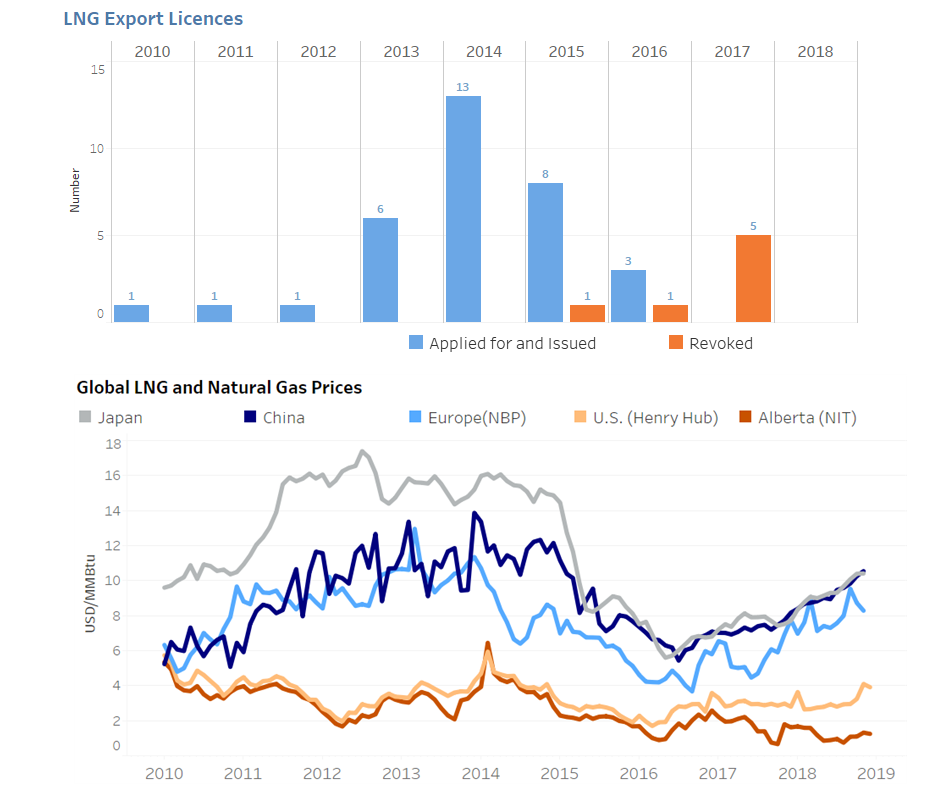Market Snapshot: Update on Canadian LNG export facilities and licences
Release date: 2019-03-13
Since the National Energy Board (NEB) released Canada’s Role in the Global LNG Market, some LNG export projects have made steps forward and others have taken steps back. In October 2018, LNG Canada made a final investment decision to build an LNG export facility in Kitimat, British Columbia. In October, Pieridae Energy received its provincial permit to construct an LNG facility in Goldboro, Nova Scotia. The Woodfibre LNG project received Squamish First Nations approval in November 2018, in addition to its earlier provincial and federal environmental assessment approvals. Meanwhile, FortisBC announced it will continue to export small volumes of LNG to China from its Tilbury facility in Delta, British Columbia.Footnote 1
In December 2018, WCC LNG withdrew its application from both provincial and federal environmental assessment processes. In February 2019, Steelhead LNG announced its Sarita Bay export facility would be delayed indefinitely, and it cancelled its Malahat project in December 2017.
Figure 1: Long term LNG export licenses and global LNG prices

Source and Description
Source: NEB, NGX, IHS Markit
Description: The bar graph shows the number of Canadian LNG export licences applications (for which licences were later issued) and revocations applications for each year from 2010 to 2019.
- 2010: 1 licence application, 0 revocations
- 2011: 1 licence application, 0 revocations
- 2012: 1 licence application, 0 revocations
- 2013: 6 licence application, 0 revocations
- 2014: 13 licence application, 0 revocations
- 2015: 8 licence application, 1 revocations
- 2016: 3 licence application, 1 revocations
- 2017: 0 licence application, 5 revocations
- 2018: 0 licence application, 0 revocations
- 2019: 1 expected revocation
The line graph shows monthly natural gas and LNG prices ($US per MMBtu) in Japan, China, and Europe (NBP), as well as Henry Hub (U.S.) and AB-NIT (Alberta) gas prices from 2010 to 2018. In January 2010, prices are nearly $10 in Japan, $5 in China, and around $6 in Europe. Prices peak between 2012 and 2014 before decreasing throughout 2015 and 2016. In 2016, prices reached $8 in Japan, $7 in China, and $6 in Europe. Meanwhile, in 2010, Henry Hub and AB-NIT gas prices began to diverge from Asian and European LNG and gas prices. In January 2010, prices were nearly $6 at Henry Hub and around $5 in Alberta. Prices peaked in 2014 to $6 at Henry Hub and over $6 in Alberta before decreasing to around $2 at Henry Hub and below $2 in Alberta during 2016. In 2018, prices reached or surpassed $10 in Japan and China, and $9 in Europe. Meanwhile, 2018 prices at Henry Hub reached $4 and prices in Alberta were below $2.
Background
In 2010 NEB started receiving applications for long term licences to export natural gas as LNG to non U.S. markets (Figure 1). Between 2010 and 2014, when crude oil prices were rising, LNG prices in Asia were also rising which encouraged many Canadian companies to propose LNG export facilities. Global LNG prices are higher than North American natural gas prices (Figure 2). Countries in Asia and Europe traditionally pay LNG prices that are linked to crude oil prices. Some major LNG consuming countries produce little natural gas of their own. At the same time, Canada has large natural gas resources and production, so some companies wanted to take advantage of higher global prices by exporting Canadian natural gas.
The number of long-term LNG export licence applications [EXCEL 19 KB] to the NEB peaked in 2014. Starting in late 2014, however, global oil prices fell, which put downward pressure on LNG prices. Meanwhile, several new LNG export facilities came online around the world, and the LNG market went from undersupplied to oversupplied, which put more downward pressure on global LNG prices. This caused the number of long term LNG export license applications to fall. Currently, 26 of the 33 LNG export licences issued by the NEB remain in place.Footnote 2 Some licences were revoked when companies obtained new, 40 year gas export licences.Footnote 3 Others were revoked when companies decided to stop developing their proposed projects.
None of the proposed large-scale LNG export facilities have been built yet.
- Date modified:
